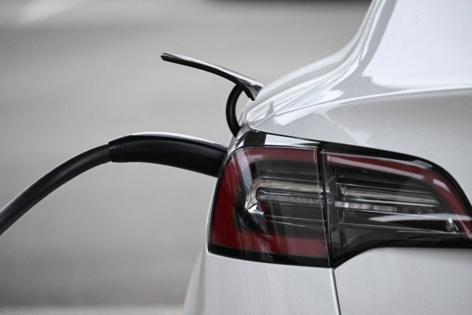Federally funded EV charging is arriving in the Philly region
Published in Automotive News
Drivers in southeastern Pennsylvania will soon bear witness to the federal government's investment in electric vehicle charging.
The first EV charging hub in the region funded through the National Electric Vehicle Infrastructure (NEVI) program money is expected to open this summer in Aston.
"In Pennsylvania, we now have two NEVI sites operational," said Colton Brown, PennDot's alternative fuels infrastructure coordinator. "I think there's right around 10 or 11 sites operational in the country, so we have two of them."
The first Pennsylvania site came online in December, and the other in early June. Pennsylvania, one of 33 states to take advantage of the NEVI funding, has been among the leaders in building EV charging stations.
The three sites will be among more than 80 funded in the state through three rounds of federal money distribution, with most expected to be built by the end of 2025.
The NEVI program was designed to provide charging along high-speed corridors and make it possible for EV owners to drive to more places around the country without suffering from crippling range anxiety. The goal, funded with $171.5 million through the federal Inflation Reduction Act signed in August 2022, is to have chargers every 50 miles along major highways.
The program is just one part of the solution, dovetailing with home chargers and other charging systems available at places where people shop or dine. In fact, the next step for PennDot will be gathering community and industry input on how best to fund community projects.
Charging an EV is not like gassing up the old Chevy. It takes 20 or 30 minutes to fully charge on a DC fast charger, like those funded by the NEVI money, and those are most useful during long trips. Level 2 chargers add 25 or 30 miles during an hour of charging, and are used in home chargers, at many service stations and retailers, and in public charging stations.
The need for public chargers is only expanding. Battery-only vehicles had their strongest sales year in 2023 — 1.2 million models sold, a fivefold increase from 250,000 EVs sold just three years ago — and that growth continues.
KBB.com reported that first-quarter sales this year were up just 2.6% over 2023 Q1 to 268,909 vehicles. In mid-June, though, KBB reported EV sales are getting a new jolt, with 14% more EVs registered in April than in March.
So EV infrastructure can hardly be built fast enough.
The NEVI project has involved considerable federal money and as expected, has received considerable scrutiny for the time it's taken to even get the few stations online.
"It took about 100 years to fully build out the gas-powered vehicle infrastructure, and we're not going to get this done in 12 months or 24," Barry Powell, head of Siemens Electrical Products, North America, told the Bipartisan Policy Center in a May teleconference on EV infrastructure.
A lot of the design and planning time has been spent on things that drivers of gasoline-powered automobiles take for granted — standardized payment systems, accessing the power for the chargers, how to keep systems maintained.
"While the U.S., for example, has nearly 197,000 gas stations, the charging network across the country is about one-third that size," wrote Sam Fiorani in the June edition of the AutoForecast Solutions newsletter, co-written with analyst Conrad Layson. Fiorani is vice president of that company.
The Washington Post reported in May that charger growth has lagged behind EV sales. The newspaper said that in 2016, there were seven EVs per public charger, and now there are 20.
"We have a national goal presently set for EV chargers and we feel like we are well on the way to meeting that goal," Scott Goldstein, deputy assistant secretary for transportation policy with the U.S. Department of Transportation, told the Bipartisan Policy Center at the May panel discussion. "Currently in 2024 we have over 183,000 chargers online across the country; if I'm not mistaken, that's 75,000 more than 2020."
A development at Tesla in May seemed like an impediment to charger growth. The company's ever-volatile chief, Elon Musk, abruptly eliminated the company's charging department, long one of the most reliable network of chargers, one that most manufacturers have recently agreed to adapt to for their connector ports.
That debacle had the potential to cause trouble in NEVI paradise, but so far it hasn't hit Pennsylvania, even though the company had contracts for 13% of the NEVI chargers in the U.S., according to AutoForecast Solutions.
For PennDot, only one Tesla charger has been withdrawn, and that was due to "other hiccups," Brown said.
"There was a little bit of uncertainty all around at first," Brown said. "But after some time they fully committed to proceeding with their projects."
The first NEVI-funded station online, the Pittston Pilot Travel Center southwest of Scranton, where I-81 and the Northeast Extension meet, has been a success so far, according to PennDot. In the first quarter of 2024, it's provided 28,945 kWh of electricity through 660 charging sessions, which could power nearly 100,000 miles of travel. The second station was along I-80 in Emlenton, which opens up some new ground for EV drivers in a remote stretch between State College and Slippery Rock.
The NEVI program has always been designed to set the stage for private investment in EV charging, as EVs become more popular sellers. In southeastern Pennsylvania, that's been well on its way, as convenience stores like Wawa have been providing charging stations for years.
The Delaware County-based convenience store chain, which installed its first charger in 2017, marked a milestone in its electric vehicle journey in 2023: It reached its 150th store to offer electric vehicle charging, according to Convenience Store News.
But the company hasn't rested on its laurels — 174 of its more than 1,050 stores now have charging, according to Wawa spokesperson Lori A. Bruce, for a total of 1,523 charging positions.
Consumer Reports, in a study called Charging the Future, said Wawa and Sheetz — a western Pennsylvania phenomenon that is spreading its way into our region — are leading the convenience store category with more than 10% of locations providing EV charging. Neither 7-Eleven nor Circle K — among the largest of the convenience store chains — provides charging at more than 1% of store locations.
While most Wawa stores host Tesla superchargers, which are the fast-charging variety, most retailers are providing only level 2 charging.
The Consumer Reports study notes that the only retailer to offer EV charging at nearly 100% of its stores is IKEA. It cited Kohl's as making significant investments in charging as well. Walgreens is another store cited for progress.
Walmart and Target have chargers at about 10% of locations.
The market is definitely on the rise in the Keystone State. Pennsylvania had 69,830 EV registrations as of May 31, according PennDot, and between 1 and 2% of vehicles in the Philly region are registered as electric. (However, the percentages by zip code are likely undercounted, Brown cautioned, because leased EVs are registered to the address of the leasing company.)
Another downside to EV charging has been out-of-order stations. PennDot has another $5 million from a separate program to address repairing broken chargers.
But for now, the NEVI money is expected to open up more corridors to EVs in a whole new way, making secure long-distance travel a new possibility.
Now, PennDot is looking to get the rest of its first 52 projects up and running, then another 29 from its second funding round, but it doesn't stop there.
"Our third funding round, which is much smaller, we're just looking for the last few gaps to fill in," Brown said.
Proposals from vendors for that round are due at the end of this month, and after that, PennDot will turn its attention to community projects, taking input from community members and business leaders about exactly what type of projects will work best.
_____
©2024 The Philadelphia Inquirer, LLC. Visit at inquirer.com. Distributed by Tribune Content Agency, LLC.








Comments